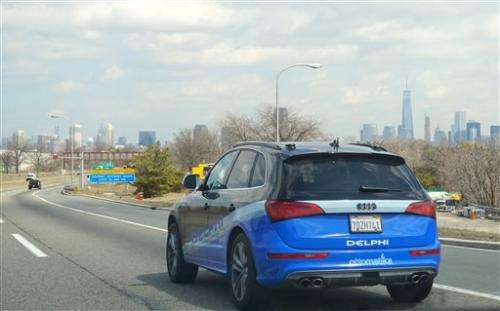Autonomous car completes 3,400-mile US road trip

An autonomous car's recent 3,400-mile U.S. road trip proves there's at least one thing computers do better than humans: Follow the speed limit.
Auto supplier Delphi Corp. fitted an Audi Q5 with radar, cameras and laser sensors to navigate the 15-state journey from San Francisco to New York, mostly traveling on highways. The car drove itself 99 percent of the time, Delphi said Thursday.
Along the way, the autonomous Audi never drove above the speed limit, even when everyone else did. As a result, other drivers subjected the car—and its human occupants—to "a few hateful gestures," said Jeff Owens, Delphi's chief technology officer Jeff Owens.
The person sitting in the car's driver seat intervened once when traffic was weaving around in a construction zone, and again when the car didn't want to move into a busy left lane to avoid police stopped on the right shoulder. The car also got a little skittish when it was next to semi-trailer trucks, edging over to avoid them. But for the most part, it easily navigated bridges, traffic circles and open highways, even in heavy rain, Owens said.
"We expected we would be in autonomous mode most of the time, but to be in it close to 99 percent of the time was a pleasant surprise," Owens told The Associated Press Thursday. "The equipment was flawless."
Delphi engineers collected nearly three terabytes of data—equivalent to 30 percent of all of the printed material in the Library of Congress—that they can use to further enhance autonomous driving systems.
One surprise: The variation in lane markings across states and communities. Some had wide white stripes, others had narrow yellow ones. Some were new, some were faded, and some were marked with raised bumps. Delphi will have to further train its cameras to detect all kinds of lane markings, since that's one way autonomous cars keep themselves centered in a lane, Owens said.
Owens said the cameras also got a little blinded in bright sunlight and in rainy weather, but the radar systems always provided backup. The radar, he said, worked well even on metal bridges, which can cause signals to bounce around.
Delphi will use the lessons it learned to improve the systems that will eventually be used in autonomous and even driverless cars. Earlier this week, Audi AG announced that Delphi will produce a new central computer system that will process the data from various cameras and sensors and tell a car how to respond. The system will appear in Audis in about two years. Delphi is also supplying Volvo with the radar- and camera-based system that enables automatic braking, lane departure warning and other safety features on the upcoming XC90.
"This technology has come so far. It's going to make such a difference in the accident statistics," Owens said.
© 2015 The Associated Press. All rights reserved.





















